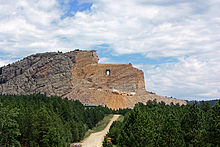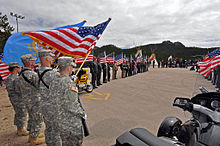- Crazy Horse Memorial
-
Crazy Horse Memorial 
Artist Korczak Ziolkowski Location Custer County, South Dakota, United States 43°50′12.44″N 103°37′27.79″W / 43.8367889°N 103.6243861°W The Crazy Horse Memorial is a mountain monument complex that is under construction on privately held land in the Black Hills, in Custer County, South Dakota. It represents Crazy Horse, an Oglala Lakota warrior, riding a horse and pointing into the distance. The memorial was commissioned by Lakota elder Henry Standing Bear to be sculpted by Korczak Ziółkowski. It is operated by the Crazy Horse Memorial Foundation, a private non-profit organization.
The memorial consists of the mountain carving (monument), the Indian Museum of North America, and the Native American Cultural Center. The monument is being carved out of Thunderhead Mountain on land considered sacred by some Oglala Lakota, between Custer and Hill City, roughly 17 miles from Mount Rushmore. The sculpture's final dimensions are planned to be 641 feet (195 m) wide and 563 feet (172 m) high. The head of Crazy Horse will be 87 feet (27 m) high; by comparison, the heads of the four U.S. Presidents at Mount Rushmore are each 60 feet (18 m) high.
The monument has been in progress since 1948 and is still far from completion.[1] If completed, it may become the world's largest sculpture, as well as the first non-religious statue to hold this record since 1967; the last being Russia's Mamayev Monument.[2]
Contents
History
In 1929, Henry Standing Bear, a Lakota elder, initiated the project to honor Crazy Horse by writing to the sculptor Korczak Ziółkowski, saying in part, "My fellow chiefs and I would like the white man to know that the red man has great heroes, too."[3] The Polish-American sculptor had worked on Mount Rushmore in 1924 under Gutzon Borglum. Standing Bear and Ziolkowski scouted potential monument sites together. Ziolkowski suggested carving the memorial in the Wyoming Tetons where the rock was better for sculpting, but the Sioux leader insisted it be carved in the Black Hills, which are sacred to Lakota culture.[4] After making models, Ziolkowski started blasting for the monument in 1948.
The memorial is a non-profit undertaking, and receives no federal or state funding. The Memorial Foundation charges fees for its visitor centers and makes income from its gift shops as well. Ziolkowski reportedly was offered $10 million for the project from the federal government on two occasions, but he turned the offers down. He felt that the project was more than just a mountain carving, and he feared that his plans for the broader educational and cultural goals of the memorial would be overturned by federal involvement.[5]
Ziolkowski died in 1982, and it was 16 years later that the face of the sculpture was completed. The entire complex is owned by the Crazy Horse Memorial Foundation. Ziolkowski's wife Ruth and seven of their ten children work at the memorial, which has no fixed completion date.[3] The face of Crazy Horse was completed and dedicated in 1998.[6] Their daughter Monique Ziolkowski, a sculptor, has modified some of her father's plans to make the sculpture work better, and the foundation received reports from two engineering firms in 2009 to help guide completion of the project.[7]
Completed vision
The memorial is to be the centerpiece of an educational/cultural center, to include a satellite campus of the University of South Dakota, with a classroom building and residence hall, made possible by a US$2.5 million donation in 2007 from the Sioux Falls, South Dakota philanthropist T. Denny Sanford. It is called the University and Medical Training Center for the North American Indian and the Indian Museum of North America. The current visitor complex will anchor the center.[3] He also donated $5 million to the memorial, to be paid $1 million a year for five years as matching donations were raised, specifically to further work on the horse’s head.[7]
Paul and Donna “Muffy” Christen of Huron, South Dakota in July 2010 announced they are donating $5 million in two installments to an endowment to support the operation of the satellite campus. It holds classes in math, English and American Indian studies courses for college credit, as well as outreach classes. The memorial foundation has awarded more than $1.2 million in scholarships, with the majority going to Native students within South Dakota.[7]
Fundraising and events
The foundation sponsors Native American cultural events and educational programs. Annually in June, the Memorial hosts a Volksmarch, which is the only time that the public is permitted on the mountain. Attendance has grown to as many as 15,000.
Much of the earth-moving equipment used is donated by corporations. The work on the monument has been primarily supported by visitor fees, with more than one million people visiting annually. The visitor center contains many pieces of rock blasted from the mountain: visitors may take samples in exchange for a small donation.
The Memorial began its first national fund drive in October 2006.[1] The goal was to raise $16.5 million by 2011. The first planned project was a $1.4 million dormitory to house 40 American Indian students who would work as interns at the memorial.[8]
Periodically the memorial publicizes blasting events, which attract thousands of people from all over the region. They may wait for hours as the clock counts down. The gala ends in numerous near-simultaneous detonations, and a great tumbling of rocks and dust down the mountain.
Controversies
Crazy Horse resisted being photographed, and was deliberately buried where his grave would not be found. Ziolkowski envisioned the monument as a metaphoric tribute to the spirit of Crazy Horse and Native Americans. "My lands are where my dead lie buried," was reportedly said by Crazy Horse, and that is the symbolism of his extended hand on the planned monument.[3]
Elaine Quiver, a descendant of Crazy Horse, said in 2003 that the elder Standing Bear should not have petitioned Ziolkowski to create the memorial. She believes that Lakota culture is based on getting a consensus from family members for such a decision, and no one asked the opinions of the descendants of Crazy Horse before the first rock was dynamited in 1948.[9] She said,
"They don't respect our culture because we didn't give permission for someone to carve the sacred Black Hills where our burial grounds are. They were there for us to enjoy and they were there for us to pray. But it wasn't meant to be carved into images, which is very wrong for all of us. The more I think about it, the more it's a desecration of our Indian culture. Not just Crazy Horse, but all of us."[9]
Seth Big Crow, whose great-grandmother was an aunt of Crazy Horse (the Lakota are a matrilineal culture), said he wondered about the millions of dollars which the Ziolkowski family had collected from the visitor center and shops associated with the memorial, and "the amount of money being generated by his ancestor's name." He said,
"Or did it give them free hand to try to take over the name and make money off it as long as they're alive and we're alive? When you start making money rather than to try to complete the project, that's when, to me, it's going off in the wrong direction."[9]
Other traditional Lakota oppose the memorial. In a 1972 autobiography, Lame Deer, a Lakota medicine man, said: "The whole idea of making a beautiful wild mountain into a statue of him is a pollution of the landscape. It is against the spirit of Crazy Horse."[10] In a 2001 interview, the Lakota activist Russell Means said: "Imagine going to the holy land in Israel, whether you're a Christian or a Jew or a Muslim, and start carving up the mountain of Zion. It's an insult to our entire being."[11]
See also
- List of colossal sculpture in situ
- List of statues by height
- List of the tallest statues in the United States
References
- ^ a b Walker, Carson (June 2, 2008). "Crazy Horse Memorial turns 60 with no end in sight". USA Today. http://www.usatoday.com/news/nation/2008-06-02-2619407123_x.htm. Retrieved 2011 July 17.
- ^ Karg, Barb; Sutherland, Rick (2010). Secret America: The Hidden Symbols, Codes and Mysteries of the United States. Adams Media. pp. 232–233. ISBN 978-1440505539.
- ^ a b c d Crazy Horse Memorial Frequently Asked Questions
- ^ Obidinski, Eugene. "Storyteller in Stone". Polish American Journal. http://www.polamjournal.com/Library/APHistory/crazyhorse/crazyhorse.html. Retrieved 14 August 2010.
- ^ Crazy Horse Memorial, Press Release, April 21, 2003
- ^ Higbee, Paul, "Carving Crazy Horse", American Profile, April 27, 2001
- ^ a b c Soderlin, Barbara. "Progress quiets Crazy Horse doubts". Rapid City Journal. http://www.rapidcityjournal.com/news/article_5b86289c-dcab-11de-9917-001cc4c002e0.html. Retrieved 14 August 2010.
- ^ "Crazy Horse Memorial fund drive to begin", Associated Press, August 21, 2006
- ^ a b c "Crazy Horse Memorial Generates Mixed Feelings", Voice of America News, 13 September 2003, accessed 21 June 2011
- ^ Lame Deer, John (Fire) and Richard Erdoes. Lame Deer Seeker of Visions. Simon and Schuster, New York, New York, 1972. Paperback ISBN 0-671-55392-5
- ^ Roberts, Chris "Russell Means - American Indian Movement activist - Interview", The Progressive, September 2001, retrieved September 16, 2007
External links
Categories:- 1948 establishments
- Black Hills
- Great Sioux War of 1876–77
- Native Americans in art
- Colossal statues
- Geography of Custer County, South Dakota
- Monuments and memorials in South Dakota
- Mountain monuments and memorials
- Construction projects in the United States
- Outdoor sculptures in South Dakota
- Lakota
- Native American museums in South Dakota
- Museums in Custer County, South Dakota
- Biographical museums in South Dakota
Wikimedia Foundation. 2010.


